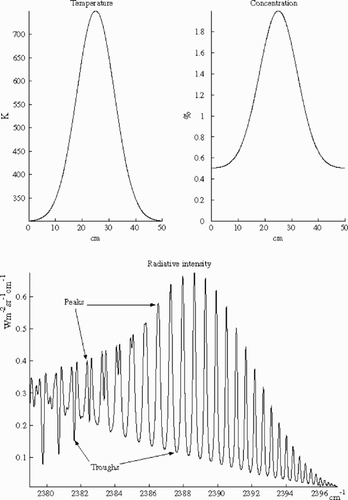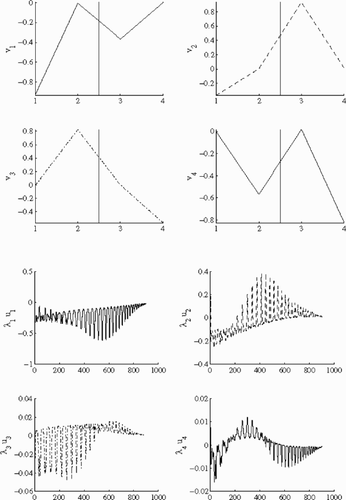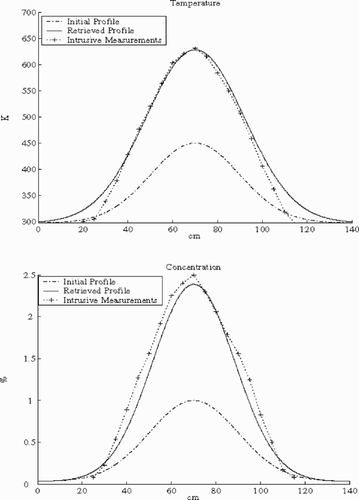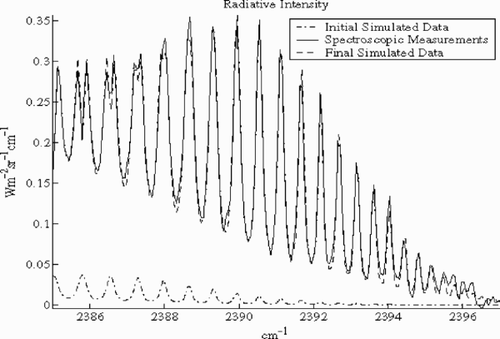Abstract
This article deals with the inversion of spectroscopic measurements to obtain temperature and concentration profiles of a gas. The Radiative Transfer Equation (RTE) is discretized as a one-dimensional equation to simulate a spectrum and adjoint state method is used to compute the sensitivity matrix. The Singular Value Decomposition of the sensitivity matrix enables analyzing information content of a spectrum, and defining the number of retrievable parameters for a noise level. This number and the rank of the sensitivity matrix indicate the difficulty of data inversion. When inversion seems difficult, regularization is necessary and information about profiles is included using parameterization. This method is applied on CO2 radiation, where inversion of simulated data for Gaussian distributions is studied to know what to do with real case data. Finally, real case inversion is performed for spectroscopic measurements carried out on the exhaust of a motor.
1. Introduction
There are several studies about the inversion of the Radiative Transfer Equation (RTE) in order to find temperature distribution and some medium characteristics, or to calculate some source properties for industrial or ecological purpose. In the literature, efforts have been reported on the reconstruction of flame temperature. Determining gas distribution is an additional requirement to be pulled out from spectroscopic data. We cite here Yousefian et al. Citation[4,Citation5] who have used infrared emission to retrieve temperature and concentration profiles for moderately noisy measurements in axisymmetric flames by Abel Inversion. Liu et al. Citation[10,Citation12] worked on the estimation of temperature, spectral absorption coefficient, source-term distribution in a non-grey medium. Measuring temperature in order to retrieve some radiative parameters is the subject of other works like Park and Yoon Citation[8,Citation9].
The accumulation of high-resolution spectroscopic data motivates the use of more generic methods that can be applied for various wave numbers, instrument resolutions, and molecules in a gas. Here we present a tool to study the influence, on radiation intensity, of temperatures and concentrations of a molecule in a gas, and how to use their influence to retrieve their distributions in the observed medium. An application on CO2 radiation is given for both the simulated data and real case data.
To study this phenomenon, the main hypotheses proposed for the physical model are local thermal stability and establishment of temperature and concentration profiles. Additional simplifying hypotheses, related to a first-order approximation of the real behavior of a flame gas, are made here. They consist of considering the gas real index as equal to one and neglecting all the following: the particles emission absorption (for example soot's particles), the reflection at the air–gas interface and the scattering effect compared with the emission–absorption one.
Since the numerical resolution of the one-dimensional RTE is very fast on modern computers, then numerical efficiency is not the main issue here, and the differential formulation of RTE is chosen, for its simplicity, to simulate spectroscopic data. A very important question rarely answered is evaluating, before inversion, the number of parameters which can be extracted from a given set of spectroscopic measurements. We address this problem by performing the singular value decomposition SVD of the Jacobian matrix Citation[1–Citation3,Citation6], where data sensitivity to parameters variation is analyzed and a definition of the number of retrievable parameters for a noise level is given. Jacobian is computed, using an adjoint state technique, at a cost independent of the number of unknown parameters (it depends only on the discretization of the RTE). Gaussian distribution is chosen for both temperature and concentration profiles to apply this method on simulated data related to CO2 spectrum. Results of this application enables understanding and the ability to decide what to do for real case data.
The CO2 spectrum radiation is studied between 2379 and 2397 cm−1, which is in the range of high sensitivity with respect to the temperature, so we hope for a good estimation and stability of the temperature's parameters.
We estimate the temperature and concentration profiles by minimizing the misfit of the modeled spectrum to the measured spectrum, using the trust region method, where linearized problems are solved by the Gauss–Newton algorithm, and linear systems are solved by the conjugate gradient method.
2. Direct and inverse problem for RTE
For the previous hypotheses the radiation intensity Lσ(x) measured at a point x emitted by the quantity of gas situated at the left of x (see ) depends on distributions between 0 and x of temperature T and concentration C of the studied gas.
This dependence is expressed by the following differential equation:
(---219--1)
(---219--2)
where
| 1. | K σ (T,C) is the monochromatic absorption coefficient of the gas for a wave number σ at temperature T and concentration C. This coefficient is expressed by:
| ||||
| 2. |
| ||||
| 3. | The initial value, Lσ , 0 represents the background radiation for the wave number σ. In this article, there is no background radiation, so its value is null. | ||||
We measure, by a detector located at x = d, the radiation intensity (---219----3) resulting from absorption and emission by the gas situated to the left of x = d, see . The wave number σ is in a given set of wave numbers Σ covering the spectrum of interest. For every wave number σ ∈ Σ, temperature profile T and concentration profile C, we compute the solution Lσ of the differential Equationequation (1)
(---219--1) for the initial condition Lσ 0 = 0. We denote the radiation intensity Lσ(d) computed at x = d by:
(---219--5)
So we have to solve the following non-linear equations:
Find the two profiles that satisfy:
(---219--6)
The least squares formulation of this problem is the minimization problem:
(---219--7)
If we assume that T and C profiles are in the space
(---219----4) of continuous functions over [0,d], then their space is infinite-dimensional space: this fact compared to the finite number of data shows the ill-posedness nature of this problem where clearly there is no uniqueness neither stability of the solution. Consequently regularization is necessary, where a priori information about profiles is used. This a priori information is a fixed shape for both of functions T and C, parameterized by ‘few’ parameters. But first we have to discretize the RTE, and perform sensitivity analysis to have an idea about the difficulty of this inverse problem.
3. Discretization and sensitivity analysis
For a wave number σ ∈ Σ, and two distributions T and C in [0,d] for temperature and concentration respectively we want to evaluate (---219----5) defined in Equation(5)
(---219--5) . Let
(---219----6) be a uniform subdivision of the segment [0,d] with a step of h=d/N, and we associate to this subdivision the following piecewise constant approximations for temperature and concentration profiles, which are denoted by:
(---219--8)
(---219--9)
The searched discrete profiles are then in finite-dimensional space of dimension 2N. The radiative intensity Lσ , evaluated at the discretization points
(---219----7) , gives the following vector:
(---219--10)
To evaluate L, the simplest explicit Euler scheme is chosen for the resolution of the differential Equationequations (1)(---219--1) and Equation(2)
(---219--2) . This resolution gives the following state equations:
(---219--11)
(---219--12)
(---219--13)
and
(---219--14)
The scheme Equation(14)(---219--14) is of order one with respect to h, so a small value for h is necessary to have a good precision on the discrete solution L as an approximation of the solution of Equation(1)
(---219--1) . This scheme is stable under the condition:
(---219--15)
which must be satisfied in the numerical tests. Once the recurrence system Equation(14)
(---219--14) is solved, the discrete value, noticed as well by
(---219----8) , is given by:
(---219--16)
Consequently, for the wave number σ, the following discrete forward map is perfectly defined:
(---219--17)
The gradient of (---219----9) with respect to the 2N-dimensional vectors (T, C) is computed by an adjoint state technique (see Appendix A). First the adjoint equation has to be solved:
(---219--18)
(---219--19)
(---219--20)
(---219--21)
then derivatives with respect to piecewise constant distributions Equation(8)
(---219--8) and Equation(9)
(---219--9) can be expressed as:
(---219--22)
(---219--23)
Since temperatures and concentrations are of different scales, which influences the sensitivity study, then adimensionalized variables have to be used to reduce this effect. We denote the new adimensionalized distributions by:
(---219--24)
where the values of Tm and Cm are in our case:
(---219--25)
The new application:
(---219--26)
is denoted by
(---219----10) as well, and we specify the variable when it is necessary to avoid confusion. Its derivatives are:
(---219--27)
we denote by
(---219----11) the line vector of these derivatives. The simulated spectrum for all wave numbers of Σ is defined as:
(---219--28)
whose derivatives give the sensitivity matrix of the spectrum, denoted by:
(---219--29)
The main tool used to study sensitivity is the Singular Value Decomposition (SVD) of the sensitivity matrix Citation[2], it gives:
(---219--30)
In this expression
(---219----12) are the right singular vectors in the parameter space,
(---219----13) are the left ones, where I is the number of wave numbers in Σ, Λ contains the singular values of
(---219----14) , which are positive here, in a decreasing order. For a singular value λ, if we denote by vλ and uλ the corresponding right singular vector and the left one, we can write:
(---219--31)
When λ is non-zero, parameters variations in the direction vλ imply variations in measurements in the direction uλ of modulus λ. So the rank of the sensitivity matrix, which equals the number of non-null singular values, indicates the amount of ‘independent’ or ‘non-correlated’ information about parameters contained in the measurements. But a small singular value λ implies a small effect in measurements space. This effect may be easily hidden by noise in measurements, thus making it impossible to retrieve the component of the parameter in the corresponding singular direction uλ. In the following section the number of retrievable parameters is defined for a given noise level; it indicates the difficulty of the inversion of the corresponding data.
4. The number of retrievable parameters
In this section, the techniques used and their results are written for adimensionalized parameters. The way to generalize these results for another type of parameterization is described at the end of the section.
We assume that the measured spectrum (---219----15) is a perturbation of the true spectrum
(---219----16) :
(---219--32)
where δL accounts for the noise. When the model is perfect to represent the reality, we can write for true distributions t0,c0):
(---219--33)
Here we assume that the model is perfect then this hypothesis holds clearly for simulated data. For real case data, if the model is not really good, then inversion may guide modelization effort to get a better model to represent the reality.
We want to investigate in how many independent directions the parameters t and c can be confidently retrieved from the noisy data (---219----17) . For this purpose we linearize the forward model at t0, c0) and perform the SVD of
(---219----18) , which amounts to consider that parameters variations (δ t ,δ c) are a minimizer of the quadratic function:
(---219--34)
The decomposition of (δ t,δ c) on the basis of right singular vectors V gives:
(---219--35)
The decomposition of δL on the left singular vectors U gives:
(---219--36)
If the noise δL has a null component on the image of the linear application
(---219----19) then the minimizer of Jlin is the null vector, and consequently there is no effect of the noise on the solution. We consider then that δL is in the image of
(---219----20) to study its effect. In this case, if we denote by NK the rank of the sensitivity matrix, then the minimizer of Jlin is immediately given by:
(---219--37)
where λi is the ith singular value of the sensitivity matrix, so that:
(---219--38)
This inequality controls the absolute value of the error in the estimated parameters. The controlling factor 1/λi explodes for little values of λi ; in this case we do not really control errors of estimated parameters. On the other hand, it is interesting to try to control the relative errors of the parameters. For this purpose we need to check some properties of the forward application (---219----21) as convexity. Because the forward model is defined by an intermediate resolution of a differential equation, its convexity cannot be shown directly: we discussed in Appendix B how to check this property numerically over a segment. The result Equation(B.6)
(---219--0-6) written at the point (t0,c0) gives:
(---219--39)
Combining Equation(38)
(---219--38) and Equation(39)
(---219--39) gives:
(---219--40)
this means that the error on the ith parameter obtained by inversion is controlled by the error on the measurements amplified by the ratio λ1/λi ≥1. For an upper bound ε of the relative errors on measurements:
(---219--41)
the parameter ai is called retrievable if it satisfies λi/λ1> ε. This implies:
(---219--42)
We call Nr(ε) the number of retrievable parameters for a noise level ε. Notice that Nr(0) is the rank NK of the Jacobian
(---219----22) . These two numbers, compared to the number of parameters Np, give a quantitative idea of the difficulty of the inversion problem at hand.
We notice that the number Nr(ε) is evaluated by model linearization at a given point. For non-linear inverse problems, Jacobian differs from one point to another, so the value of Nr(ε) is local. When Nr(ε ) and Nr(0) are evaluated at true profiles (t0,c0) generating the simulated data (---219----23) satisfying Equation(33)
(---219--33) , then they indicate the difficulty to retrieve profiles (t0,c0) by inversion of the noisy data
(---219----24) of Equation(32)
(---219--32) .
For adimensionalized parameters and for the example considered in the next section, we will see that Nr(ε) and Nr(0) have small values compared to Np =12N; consequently we cannot hope that retrieving all the parameters, and regularization is necessary.
Regularization by parameterization is considered to be a good way to include information about profiles in the inversion process. Parameterization consists in searching for the temperature and concentration profiles as closed-form formula depending only on a small number of parameters whose values have to be deduced by minimizing differences between initial simulated data and objective data. Parameterization is performed by specifying an application Φ that associates temperature and concentration distributions (t ,c ) to a vector of all unknown parameters p. When applied to the problem Equation(7)(---219--7) , it gives:
(---219--43)
This ‘new’ inverse problem can be studied by the same manner as the original problem. We can define for a noise level the number of retrievable parameters for the new parameterization and compute Nr(ε) and Nr(0) in order to have an idea about the corresponding inversion difficulty. If inversion seems not very difficult, then optimization with respect to p of the objective function Equation(43)
(---219--43) may give a satisfactory result.
As for the optimization algorithm, a trust region reflective method was used here for its good performance. In this method, a local quadratic approximation of the objective function is minimized over a region called the trust region. This region depends on problem constraints and the non-linearity of the objective function. To minimize this quadratic approximation Gauss–Newton and Conjugate Gradient algorithms are the main tools used inside iterations Citation[7].
Finally, we notice that results of sensitivity, difficulty evaluation using Nr(ε) and Nr(0), and optimization are related to the choice of the set of wave numbers Σ. We check some of these properties for several subsets of wave numbers and compare information content and efficiency of the corresponding measurements to retrieve profiles for given noise levels. This could be useful in designing the measurement device, where getting the maximum of useful information with the lowest price is a crucial issue. In the numerical study, a comparison of four subsets of wave numbers is given to illustrate this idea, and we think that the result may interest designers and users of spectroscopic devices.
5. Application on synthetic data for CO2 radiation
In this section we apply results of previous sections on CO2 emission–absorption simulated spectrum. Our objective here is to understand what may happen for real case data inversion. Using simulated data is equivalent to saying that the physical model is perfect to describe the reality, and in this case the hypothesis Equation(33)(---219--33) holds. The radiative properties of CO2 for wave numbers of a set Σ are given as a table of coefficients
(---219----25) used to compute Kσ for all wave numbers. The Gaussian distributions for temperature and CO2 concentration are assumed here. Experts believe that these distributions could represent approximately what the studied motor, in the real case example, can produce as temperature or CO2 concentration during its activity cycle.
We discretize the space domain [0,d] in 200 segments, in a way that it satisfies the stability condition Equation(15)(---219--15) , and we resolve the differential Equationequation (1)
(---219--1) . With this discretization, temperature and concentration profiles are described by 200 values per profile, then we have Np = 400. The set of all wave numbers Σ contains 901 equidistant wave numbers between 2379 and 2397 cm − 1 .The simulated spectrum for Σ and Gaussian distributions for temperature and concentration, are shown in .
Sensitivity matrix for adimensionalized parameters (t0,c0) is computed, and the SVD of this matrix is performed. We plot singular vectors in order to have an idea about sensitivity of radiative intensities with respect to discretization values of temperature and concentration. shows the first six right singular vectors (---219----26) and their corresponding images
(---219----27) by the sensitivity matrix.
Every right singular vector has its first 200 components in the adimensionalized temperature space, and has the last 200 components in the adimensionalized concentration space. The part of the first right singular vector in the adimensionalized temperature space looks like the temperature profile. This is not the case for the part of this vector in adimensionalized concentration space. Since this vector corresponds to the greatest singular value, a good sensitivity for temperature distribution can be deduced. Images of the first six right singular vectors have small components for wave numbers in [2385 cm−1,2397 cm −1], then radiative intensities that may give information about temperature and concentration distributions are mainly those situated in [2379 cm−1, 2385 cm−1]. We can see clearly that λ1 u1 has the largest component in measurements space, that shows clearly the high sensitivity of measurements for parameter variations in the direction of the first right singular vector.
On the spectrum of , some subsets of wave numbers are distinguished; they correspond to local minima or maxima of radiative intensity. Besides the set of all wave numbers Σ, three subsets of wave number were specified here:
| 1. | The set of the 46 wave numbers of ‘Peaks’ corresponding to local maxima of spectrum intensity – it is denoted by Σ1. | ||||
| 2. | The set of the 47 wave numbers of ‘Troughs’ corresponding to chosen local minima of radiation intensity, denoted by Σ2. | ||||
| 3. | The mixed set of 93 wave numbers of Peaks and Troughs denoted by Σ3. | ||||
We will check the inversion difficulty for these four sets of wave numbers by evaluating the corresponding Nr(0) and Nr(ε) for the noise level ε =1%. For this purpose we compare in the curve of − 20 log10(λj/λ1 ) to the line − 20 log10ε. Evaluating the indicators Nr(0) and Nr(ε) for all subsets of wave numbers gives:
| 1. | For the set of Peaks Σ1, we have Nr(ε )=5 and Nr(0)=46. | ||||
| 2. | For the set of Troughs Σ2, we have Nr(ε )=6 and Nr(0)=46. | ||||
| 3. | For the set of Peaks and Troughs Σ3, Nr(ε )=6 and Nr(0)=56. | ||||
| 4. | For all wave numbers Σ, Nr(ε )=6 and Nr(0)=58. | ||||
Figure 4. Evaluation of Nr(1% ) corresponding to adimensionalized parameters for four subsets of wave numbers.

We noticed that the difficulty of inversion expressed by the factors Nr(0) and Nr(ε) has nearly the same order for the two subsets Σ and Σ3. If we notice that in Σ3 there are only 93 wave numbers, compared with 901 for Σ, then we can say that the set Σ3 contains almost all the information of the spectrum about parameters. Then using Σ3 can be an option to reduce measurement cost without losing a lot of their information content. Since designing devices is not our main objective here, we will use for inversion the set of all wave numbers Σ containing all information about parameters.
For all wave numbers Σ, the values Nr(ε )=6 and Nr(0)=58 compared with the total number of parameters Np = 400 shows that inversion is difficult, and estimating all parameters seems hopeless. We also checked what the inversion of the simulated data (---219----28) of may give. We see in the reconstructed profiles together with the true ones; they are very different despite the fact that they produce the same desired spectrum.
Then to obtain uniqueness, it is necessary to regularize the problem by using information about the possible shape of profiles. We suppose that the searched distributions are Gaussian, which is the case for the objective simulated data (---219----29) of , and we parameterize them using the following formulas:
(---219--44)
(---219--45)
Sometimes one has a good estimation of t∞ and c∞ , and they can be considered as the boundary values for their distributions. In such a case, we use a sub-parameterization by freezing the values of t∞ and c∞ and searching values for the remaining ones. The localization of the maximal temperature and maximal concentration values enables freezing the values of xt and xc. Here is a recapitulation of all the fixed values:
(---219--46)
The new reduced parameterization is defined by:
(---219--47)
By the same way used to deduce the inequality Equation(39)
(---219--39) , we can have a similar inequality for the new parameterization obtained at the objective point p0 which satisfies:
(---219--48)
The SVD of the sensitivity matrix (---219----30) shows the influence of parameter variations on measurements. In we see that the first right singular vector has its main component on the direction of tmax then measurements are the most sensitive to this parameter, and we expect that it may be retrieved with the best precision.
By checking the inequality Equation(39)(---219--39) for the new parameterization Φ, by the same way as it was done for the adimensionlized parameterization, we define indicators of inversion difficulty Nr(0) and Nr(ε) for a given noise level ε. These indicators are estimated for the previous four sets of wave numbers (see ). We have Nr(ε )=2 and Nr(0)=4 for all of the subsets: this means that at least a half of parameters can be retrieved for a noise level of 1% in measurements, and at most all of them will be retrieved (it was not the case for adimensionalized parameters). This interpretation is the same for all subsets of wave numbers. Then inversion for the new parameterization is more hopeful than inversion for the adimensionalized parameterization. In fact, a priori information on the Gaussian shape of profiles eliminates the kernel and small singular values of the Jacobian of the forward model. Since noise exists in real case measurements, it is necessary to perform inversion on simulated data including noise, and evaluate the noise effect on retrieving parameters. The considered noise is generated by a random uniform generator with maximum value γ. For the considered simulated spectrum
(---219----31) of maximal radiation intensity Lmax , the noise corresponding to a noise level ε is the noise of maximal amplitude of γ =ε Lmax. Three noise levels are tested: 1, 10, and 20%. For each noise level, different uniform random noises are generated and inversion is performed to retrieve parameters. We content ourselves by generating 14 different random noises for every noise level. The averaged values of parameters and the averaged relative error are given in .
Figure 7. Evaluation of Nr(1% ) corresponding to the subparameterization Φ for four subsets of wave numbers.
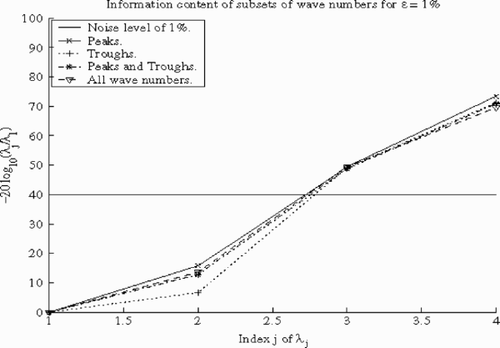
Table 1. Averaged values and averaged relative errors for different noise levels.
We noticed first that the averaged values are close to real values, but their quality is expressed by the averaged relative error, where we see clearly that for high noise levels in measurements the relative error on retrieved parameters increases. These results confirm the sensitivity analysis conclusion where we see that tmax has been retrieved with a good precision and has a good stability with respect to noise level, αt comes after, while the values of concentration parameters have less precision.
The previous study was done for other shapes of temperature and concentration profiles, where we noticed that generally we did not have sufficient information in spectroscopic measurements to retrieve all discretization values for researched distributions. Then parameterizing the profiles seemed to be efficient as a regularization method for this inversion problem.
Now we can deal with real data where we use the sub-parameterization of temperature and CO2 concentration profiles to regularize the ill-posed problem.
6. Application on real case data
Two kinds of measurements were carried out on the exhaust of Rolls–Royce Spey at DeRA, intrusive measurements and spectroscopic measurements (non-intrusive measurements). We have worked on the spectroscopic data to retrieve temperature and CO2 concentration using the previous method. Profiles were supposed, by experts of motors, to be Gaussian profiles, and they believe that Gaussian shape can describe the unknown distributions sufficiently .
We consider here the sub-parameterization defined in Equation(47)(---219--47) where the main parameters to be retrieved are:
(---219---1)
Minimizing the corresponding objective function Equation(43)
(---219--43) to spectral measurements, shown in , gives profiles shown in .
The results of the intrusive measurements are shown in order to be compared with inversion results. We do not believe here that intrusive measurements are more accurate than inversion results; neither do we believe that inversion results are more reliable than intrusive measurements. We just notice that they have close values, and this fact gives confidence in both of them. This confidence assures us that the considered model is good enough to describe the reality.
7. Conclusion
Inversion of spectroscopic data to obtain temperature and concentration distributions is an ill-posed problem. Evaluating the rank of the sensitivity matrix and the number of retrievable parameters for a noise level motivates using parameterization of profiles as a regularization technique.
Applying this method on CO2 radiation simulated spectrum in the zone [2379 cm−1, 2397 cm−1] for Gaussian distributions, enables retrieving temperature and concentration profiles for low noise levels. We notice that for high noise levels the maximal temperature value is more stable than other parameters and temperature parameters are more stable than concentration ones. With real case data, the inversion results are very close to intrusive measurements, this ensures confidence in inversion algorithm.
Nomenclature
Table
Acknowledgment
We acknowledge here DeRA for their results of intrusive measurements, and the Auxitrol company for its support.
- Chavent, G, Lavaud, B, and Kabir, N, 1998. Pushing avo inversion beyond linearised approximation, Geophysical Journal International 60 (5) (1998), pp. 665–710.
- Bjorck, A, 1996. Numerical Methods for Least-Squares Problems. Philadelphia. 1996.
- Chavent, G, 1991. On the theory and practice of non-linear least-squares, Water Resources 14 (2) (1991), pp. 55–63.
- Lallemand, M, and Yousefian, F, 1998. Inverse radiative analysis of hight resolution infrared emission data for temperature and species profiles recoveries in axisymetric semi-transparent media, Journal of Quantitative Spectroscopy and Radiative Transfer 60 (6) (1998), pp. 921–931.
- Lallemand, M, Yousefian, F, and Sakami, M, Recovery of temperature and species concentration profiles in flames using low-resolution infrared spectroscopy, Journal of Heat Transfer 121pp. 268–279, May 1999, Editor V.K. Dhir, UCLA.
- Van Loan, CF, and Golub, GH, 1996. Matrix Computation, Johns Hopkins University Press. 1996.
- Gilbert, JC, 2002. "Optimisation différentiable, théorie et algorithmes". In: ENSTA. Paris. 2002.
- Yoon, TY, and Park, HM, 2000. Solution of inverse radiative problem using a conjuguate gradient method, Journal of Heat and Mass Transfer 43 (2000), pp. 1767–1776.
- Yoon, TY, and Park, HM, 2001. Solution of inverse radiative problem using the Karhunen-Loève Galerkin procedure, Journal of Quantitative Spectroscopy and Radiative Transfer 68 (2001), pp. 489–506.
- Tan, HP, and Liu, LH, 2001. Inverse radiation problem in three-dimensional complicated geometric system with opaque boundries, Journal of Quantitative Spectroscopy and Radiative Transfer 68 (2001), pp. 559–573.
- Rothman, LS, Wattson, RB, Gamache, RR, Schroeder, J, and McCann, A, 1995. HITRAN HAWKS and HITEMP high-temperature molecular database, SPIE Proceedings 2471 (1995), p. pp. 105–111.
- Liu, LH, 2000. Similtaneous identi.cation of temperature profile and absorption coefficient in one dimensional semi-transparent medium by inverse radiation analysis, Journal of Heat and Mass Transfer 27 (2000), pp. 635–643.
Appendix A: Derivatives formula
We define the Lagrangian function:
(---219--0-1)
where
(---219--0-2)
is called the state vector, and
(---219--0-3)
is called the adjoint vector (or Lagrange vector).
For temperature and concentration profiles (T ,C), we denote by K(T ,C), L0(T) and L (T ,C), the solution vectors of state Equationequations (11)(---219--11) –Equation(14)
(---219--14) respectively. Let u(T, C) be the corresponding state vector:
(---219--0-4)
we notice that:
(---219--0-5)
Let
(---219----32) be the vector that satisfies:
(---219--0-6)
This equation leads directly to the system Equation(18)
(---219--18) –Equation(21)
(---219--21) defining the adjoint vector
(---219----33) . Then derivatives of
(---219----34) are given by:
(---219--0-7)
(---219--0-8)
this gives:
(---219--0-9)
(---219--0-10)
which gives Equation(22)
(---219--22) and Equation(23)
(---219--23) .
Appendix B: Convexity numerical check
For a real value b we denote by b the homogenous profile of all components equal to b. We establish here the formula Equation(39)(---219--39) . It follows from the fact that
(---219----35) appears to be convex (for all wave numbers) over the segment started by the homogenous profiles (0.3,0) and finished at (t0,c0), as we can see in the .
Figure 10. Convexity over the segment between (t0,c0) and (0.3,0) of radiative intensities for all wave numbers σ ∈ Σ.
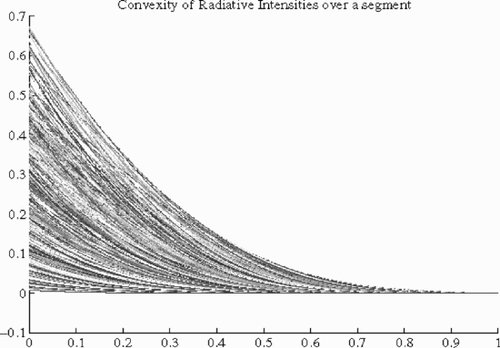
This convexity, shown numerically, implies:
(---219--0-1)
The resolution of RTE Equation(1)
(---219--1) –Equation(3)
(---219--3) for c =0 gives clearly
(---219----37) . Hence Equation(B.1)
(---219--0-1) becomes:
(---219--0-2)
This implies for all the spectra:
(---219--0-3)
and as it is t0 ≥ 0.3:
(---219--0-4)
But
(---219--0-5)
where λ1 is the greatest singular value of
(---219----38) , then:
(---219--0-6)
Finally to obtain Equation(39)
(---219--39) we notice that
(---219----39) .

